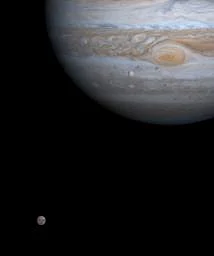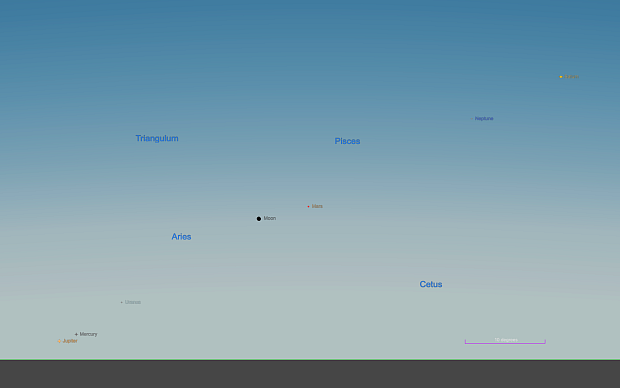The recent rare aurora sightings have left everyone in awe of nature. It is known as the Aurora Borealis, or Northern Lights, when viewed from a location close to the North Pole. The Aurora Australis, sometimes known as the Southern Lights, is what happens if you are close to the South Pole. It is an event that was visible to the unaided eye in several locations at higher elevations. Six planets and a crescent moon will align in the sky in early June, providing a new opportunity for stargazing.
Why Do Such Lineups Occur?
The planets all orbit the Sun in a comparatively flat plane, as would be seen if you were to turn our solar system around and look at it from the edge. Earth's orbit around our star defines this plane, which we refer to as the ecliptic. Since Earth's orbit defines the ecliptic, it is therefore 0° tilted from it.
.jpg)
The three brightest planets lining up for a beautiful sunset conjunction at the end of May 9, 2013. | Screen grab: Youtube (@ScienceAtNASA)
The orbits of all the other planets are slightly slanted away from the ecliptic, though not significantly; Mercury has the highest inclination, which is only 7°. The Sun, Moon, and all of the planets are situated along the ecliptic, which is visible to us from Earth when we gaze up at the sky. Furthermore, because every planet follows that same flat ecliptic, when circumstances align so that multiple planets are visible at once in the sky, they tend to stand in a straight line.

The Alignment
It is always a breathtaking sight to see, even though the geometry is not always perfect because of the tiny inclinations in the planets' orbits. In the morning sky, the planets align.
The Red Planet is currently in Cetus and will shortly enter Pisces. Saturn is floating in Aquarius near the much brighter Phi (ϕ) Aquarii, a star of 4th magnitude, than the ringed planet. Floating between Mars and Saturn, both of which are in Pisces, is the far-off ice giant Neptune, which is too dim to be seen with the naked eye. Additionally, Mercury is currently rising in Pisces, the Fish, roughly fifty minutes before the Sun.
Venus will disappear for the rest of this month and the next when it reaches superior conjunction with the Sun in early June. But forward motion is being shown by Jupiter and Uranus, which are now hidden by the glare of the Sun and will soon reappear in the early morning sky.
How To Witness The Rare Star Lineup?
To witness the 'Parade Of Planets' you have to face towards the east side on June 3, 2024, 20 minutes before sunrise, and see the alignment of the planets. On June 3, twenty minutes before sunrise, look east to see the planets neatly aligned in the sky.
Fast-Forward To Early June.
The current group of six planets includes Jupiter and Uranus, which joined on June 3. The line that forms in the pre-dawn sky runs from Jupiter, which is closest to the horizon, on the eastern end, through Mercury, Uranus, Mars, and Neptune, to Saturn, which is highest in the sky before sunrise, on the western end.
Align Your Binoculars
All six planets should be visible about 20 minutes before sunrise; however, keep in mind that Neptune (magnitude 7.8) and Uranus (magnitude 5.9) are too faint to be seen with the unaided eye and will require the use of binoculars or a telescope to be seen.

NASA's Cassini spacecraft on Dec. 7, 2000, just as two of Jupiter's four major moons, Europa and Callisto, were nearly perfectly aligned with each other and the center of the planet. | NASA/JPL/University of Arizona
But in a line spanning about 73° in the sky, Jupiter (magnitude -2), Mercury (magnitude -1), Mars (magnitude 1), and Saturn (magnitude 1) will all be easily visible to the unaided eye. Furthermore, a delicate, waning crescent moon, which is located directly to the lower left of Mars, is also ruining the festivities.
Note, however, that our Moon is not perfectly in line, and that occurs because Luna’s orbit is tilted some 5° with respect to the ecliptic. June 4, 2024, 25 minutes before sunrise, looking east to see the planets line up. June opens with Jupiter and Mercury mingling in the morning sky. The smaller planet quickly disappears from view within days. Uranus and Neptune cannot be seen with the naked eye.

On June 4th, a rare event known as the Parade of Planets will occur. Six planets along with the crescent Moon will align in a straight line. | X (@rainmaker1973)
June 4: Descend Of Mars And Mercury
The crescent moon does a little better the following morning, June 4, falling slightly farther from Mars and more closely in line. Mercury has now moved out of alignment and is now visible to Jupiter's lower right (south) as the two planets approach a close conjunction that is only 7′ apart. This is something you should not miss, especially if you have binoculars or a telescope! Looking east to see the alignment of the planets on June 5, 2024, twenty minutes before sunrise.
June 5: Mercury Replaces Jupiter On The Easternmost Point
By June 5, Mercury had moved to the lower left of Jupiter, taking over as the easternmost point in the planetary lineup from the gas giant. Furthermore, the almost new moon (only 2% illuminated) is situated above the two. June 30, 2024, an hour before dawn, gazing eastward to witness the alignment of the planets. By month's end, the moon has made a comeback to the morning sky. Rising sooner, Jupiter is above the dazzling red giant Aldebaran. Once more, take note that Uranus and Neptune cannot be seen without optical assistance.

By June 5, Mercury has replaced Jupiter as the easternmost point in the planetary line. | Alison Klesman (via TheSkyX)
Mercury disappears from view quickly as June goes on, passing near the Sun before rising again in the evening sky, leaving us with a pre-dawn sky dominated by just five planets. However, by June 30, those planets will still be arranged in a neat, straight line, spanning nearly 80° from Jupiter to Saturn (with Uranus, Mars, and Neptune in between). This morning, the Moon re-joined the line, appearing as a delicate, waning crescent that was about 33% illuminated and perfectly positioned to the upper right of Mars.
These kinds of planetary lineups are not unusual, but they are always stunning. Even if you have to rise somewhat earlier, it is well worth taking some time to stand outside and take in a clear view from your doorstep across the solar system.
Are Parade of Planets Common?
A planetary parade, also known as a visual planetary alignment, is fairly common, especially when two, three, or even four planets are aligned in the sky. Meeting five or more planets in alignment is less common, though.

Part of our solar system, along with other stars of the Milky Way galaxy, as seen over Lone Rock in Skull Valley, Utah. This view was captured facing approximately south at about 1 a.m. on July 15, 2018 | NASA
Upcoming planet lineups that may occur this year and in 2025:
June 3, 2024 (Monday)
August 28, 2024 (Wednesday)
January 18, 2025 (Saturday)
February 28, 2025 (Friday)
August 29, 2025 (Friday)






.jpg)
